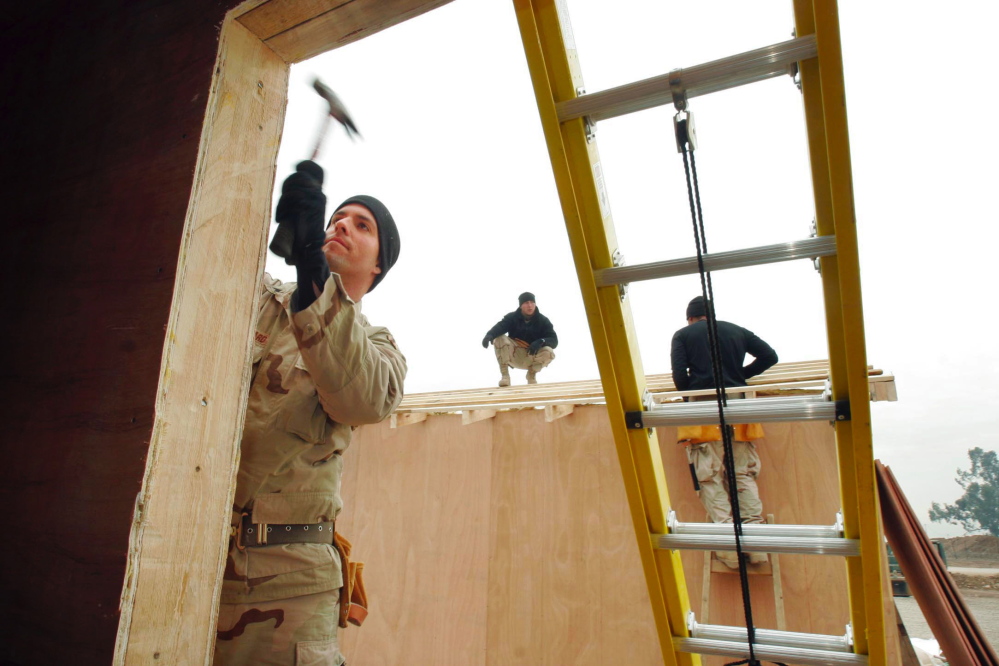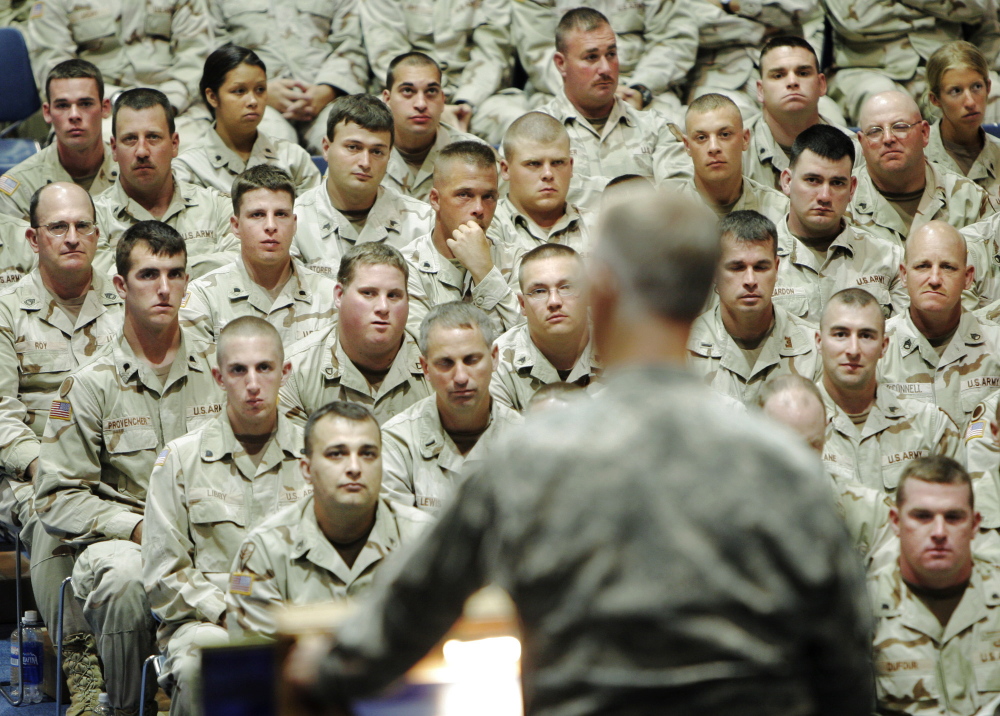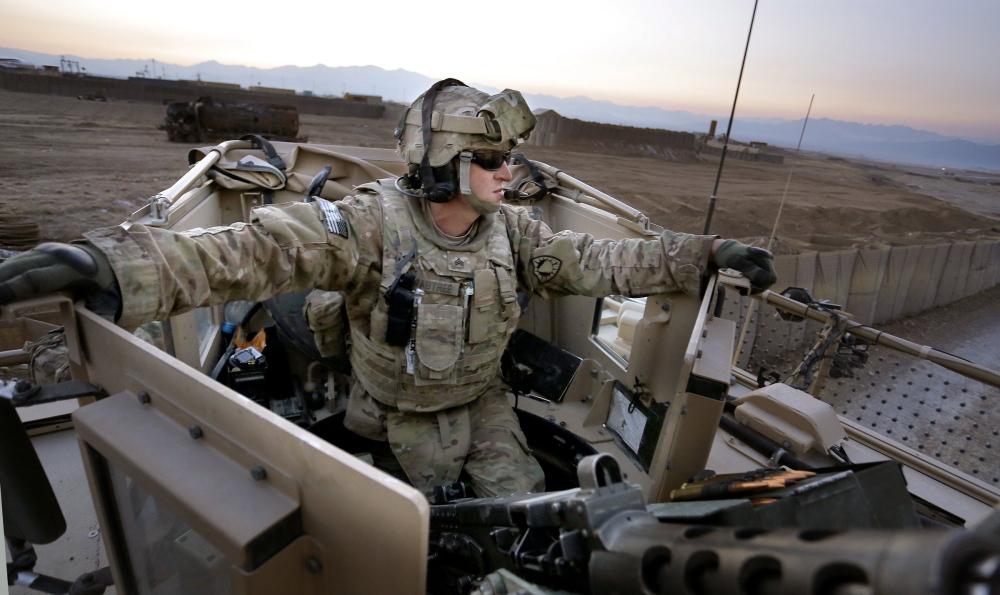The Army National Guard is nearing the final stages of a plan to reassign the 133rd Engineer Battalion of the Maine National Guard to Pennsylvania and replace it with a less specialized combat infantry unit, the Portland Press Herald has learned.
If the plan is approved, Maine will lose a battalion that handles vital engineering and construction duties during civil emergencies such as severe storms, flooding and other natural disasters, and combines training for soldiers with community service to build school athletic facilities, youth camps, nature trails, municipal sand and salt sheds, rural fairgrounds and other projects.
The engineering unit also has provided significant training opportunities for women, which likely will be diminished if a transition is made to a combat battalion.
Michel Steinbuchel, spokesman for the 133rd Engineer Battalion, said Tuesday that introducing infantry to Maine’s Army National Guard has been part of the statewide plan for the National Guard since 2008, and that recruiting for the specialized engineer positions has been harder recently than filling the ranks of the unit’s infantry.
Steinbuchel said the infantry will be a more versatile, agile force, whereas engineers need heavier, more expensive equipment and are slower to respond in times of disaster.
“What we need is units that are flexible for both state and federal missions,” Steinbuchel said. “When the governor calls for state-supported civil authority, the majority of that support in terms of heavy engineering equipment is rarely used extensively. A more flexible general-purpose unit, they tend to be more useful.”
Steinbuchel said the reorganization would reduce the overall number of enlisted Guard members, but he did not know by how many. About 2,100 soldiers are now in the Maine National Guard.
There are now 161 soldiers from the 133rd deployed to Afghanistan, to dismantle the equipment and facilities that supported combat operations there for more than a decade. The majority of U.S. military forces are expected to be withdrawn from the country by the end of 2014, according to the Department of Defense.
The shift would also mean a reduced capability for civil-service missions in times of peace, such as an annual federally funded training program in which soldiers from the 133rd do community service-type work, including recent projects at the Winthrop YMCA, in the Windham school system’s athletic department, and at the Cumberland and Windsor county fairs.
Maine Army National Guard soldiers have set up a display of heavy equipment and recruiting tables at the Cumberland County and Windsor fairs each September for more than a decade. Their presence will be missed, said Mike Timmons, president of the fair.
The soldiers usually spend the entire week at the fair, manning their exhibit and helping vendors with setting up displays or other chores, Timmons said. “I have never had anything but positive encounters with them,” he said.
Also reduced will be the job options for women, who have a far broader range of opportunities in engineering units than in infantry units, where they are restricted to non-combat support roles.
Steinbuchel could not provide exact numbers for how much the reorganization would save the National Guard, or what a potential new force level would be.
About 120 engineer-capable soldiers would remain after the reorganization, Steinbuchel said, a group that he said is sufficient to address the needs of the state during emergencies or natural disasters.
“We are looking at different options, but none of this has been finalized yet,” he said.
Gov. Paul LePage’s office did not respond to requests for comment.
Members of Maine’s congressional delegation reacted with concern.
U.S. Rep. Chellie Pingree said she worries about the potential loss of a unit that has made significant contributions in the face of natural disasters in Maine and along the eastern seaboard.
“People are really attached to them, (and) they made some very big sacrifices during the Iraq War,” Pingree said. “We will certainly voice our concerns, send a letter, meet the people who (make those decisions). I have to look at all the facts.”
If finalized, the shift could occur between 2017 and 2019, said Pingree’s spokesman, Willy Ritch. He said Maine’s National Guard unit would be one of at least three to be dissolved as part of a wide-ranging reduction of the military after the wars in Iraq and Afghanistan.
From the three units to be dissolved, five light-infantry brigades would be formed. The swap of duties would end a tradition of combat engineer service in Maine that dates back to the mid-1700s.
U.S. Rep. Mike Michaud, who is running for governor, said through a spokesman that he will soon seek answers from the unit’s commander, Brig. Gen. James D. Campbell.
Campbell was in Saudi Arabia on Tuesday and unreachable for comment.
“While I understand that these changes are part of a national force restructuring effort, I look forward to speaking directly with Brigadier General Campbell to get a clear sense of how exactly this will impact the men and women serving in Maine’s Army National Guard,” Michaud said in a written statement. “It is critical that we maintain a Guard structure here that is capable of responding quickly to a variety of situations across the state.”
Asked to comment on the plan, U.S. Sen. Angus King’s office issued a statement saying, “Senator King met with a representative of the Maine National Guard (Tuesday) evening and is working to understand the issues surrounding this matter.”
In January 2012, Pentagon leaders introduced the outline of a plan to shrink the nation’s military after the costly engagements in Iraq and Afghanistan. The vision by senior military leaders includes a smaller, leaner Army that is agile, flexible and rapidly deployable, according to a report in February prepared for members of Congress by the Congressional Research Service.
In February, Secretary of Defense Chuck Hagel announced that he would recommend reducing Army personnel levels to 440,000 to 450,000 soldiers, and if sequestration level-funding is to be imposed in 2016, a drawdown to 420,000 soldiers is possible.
While no major reductions have been proposed for the Army National Guard, some units are set for restructuring to more closely mirror the make-up of the active-duty Army. Six of the Guard’s 28 Brigade Combat Teams are expected to be reorganized this year, with others to follow through 2018. The reorganization will add about 1,000 soldiers to each Guard combat brigade, making them equal in size, at about 4,500 soldiers, to active-duty brigades.
Plans call for six more brigades to be reorganized before Sept. 30.
Matt Byrne can be contacted at 791-6303 or at:
Twitter: MattByrnePPH
Send questions/comments to the editors.






Success. Please wait for the page to reload. If the page does not reload within 5 seconds, please refresh the page.
Enter your email and password to access comments.
Hi, to comment on stories you must . This profile is in addition to your subscription and website login.
Already have a commenting profile? .
Invalid username/password.
Please check your email to confirm and complete your registration.
Only subscribers are eligible to post comments. Please subscribe or login first for digital access. Here’s why.
Use the form below to reset your password. When you've submitted your account email, we will send an email with a reset code.